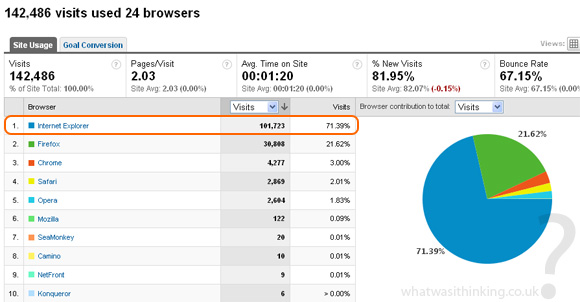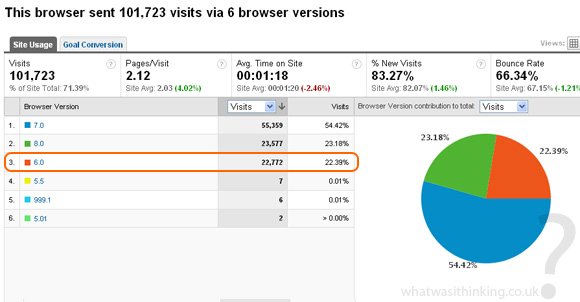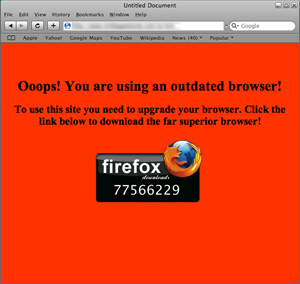 Over the last week or so, the discussion “should we continue to support IE6” has been gaining more and more momentum. Digg, Mashable, Techcrunch and other websites ran features about why IE6 should be given the boot, websites like facebook and youtube are starting to phase out the browser, hinting users to upgrade their browser.
Over the last week or so, the discussion “should we continue to support IE6” has been gaining more and more momentum. Digg, Mashable, Techcrunch and other websites ran features about why IE6 should be given the boot, websites like facebook and youtube are starting to phase out the browser, hinting users to upgrade their browser.
This sparked a long and heated debate in a number of web design agencies and clients I am working with (or have worked with / for), whether it would be worth just dropping the support for Internet Explorer 6 and ask users to upgrade their browsers so that they can enjoy the website to the fullest.
Coming from a usability, accessibility, SEO and web dev background, I thought it might be a good idea writing why I would recommend supporting (or not supporting) IE6 in the industry I am working for.
Looking at our industry – what made IE6 stay
With the release of Windows XP in October 2001, users were greeted to the new – bundled – version of Internet Explorer 6. Companies, schools and universities planning on buying new hardware tended to use resellers such as Dell to buy a number of same-spec machines at a bulk discount – and with all machines either shipping with XP or Win2000, the reign of IE6 was established.

System admins were able to roll out updates and software easily, as all machines were virtually the same, and keeping control of networks became relatively easy. Additionally, intranet software was bought or developed based on IE6, since every machine came with it this made development and testing a lot quicker and easier.
In November 2005, FireFox 1.5 became the first real free browser on the market to rival IE6 for its ease of use, and coupled with the ability to extend the browser’s capabilities through extensions it became the browser of choice – if you had the ability to choose. You see, the browser (just like 95% of all applications) needed to be installed. This wasn’t a problem on your own personal computer, but when trying to do this in an office environment (or any institution) then things were a bit more difficult: most users were not given administration rights to their machines to prevent abuse or installing malicious software. Most software requests had to go through a number of channels, from procurement (if licensing was involved) to IT (to see how much work was involved and how much time would be required per machine) to head of department (to sign the request off and add additional reasons for the request) to someone a lot higher up to ultimately sign the request off. A simple “Can I have software XYZ” could easily take months to get it approved.

With the arrival of Windows Vista and Server 2008 in October 2006, Microsoft released Internet Explorer 7, 5 years after the release of IE6. At that time, IE7 was only available for Vista and Server 2008 machines, and it was not until October 2007 that IE7 was officially available for XP machines. Companies were once again given the option to roll out IE7 to every machine under their care, however this didn’t happen: rolling out IE7 to all machines in bigger companies or institutions would not only cost a lot of time and – more importantly – money (system admin time, potential upgrade costs, etc), but the software used for business purposes (such as stock management software, accounting or counter software) was built on or running on IE6, most of the time exclusively, and paying for this software to be upgraded was a very expensive option (and sometimes the company that wrote the software did not even exist anymore).
As such, IE6 came to stay with us, and it will probably do so for a long time to come unless Microsoft was to offer free upgrades to companies and allow backwards compatibility of IE6, if only at least for the software and not for the browser use. And I somehow cannot see that happen.
.
Affecting your target audience
Now this was the general “industry” as we have it out there this year. What needs to be considered is how much of that sector fits into your target audience. Every website offers different bits of information, services or products, and each website has a different target audience with different needs or requirements and expectations of the website (if you read my article on information architecture and user testing you will be aware of different user scenarios to test a website with).
The main target audience I am dealing with is the travel and tourism industry. Our target traffic (based on a survey conducted in Jan / Feb 2008 by three of my clients) is coming from:
- Users at work, looking at holiday packages and destinations at work during their breaks – ~ 65%
- Users at home, either planning with the family or reading up on what they found at work – ~35%
Just over two thirds of traffic is coming from people using company / education networks. Depending on your target audience it might be a good idea to look at where your main traffic is coming from to paint your own picture for your market.
.
IE6 today – the stats
Let’s have a look at Google Analytics. These are the June / July stats of a holiday cottage provider based in the UK (we are looking at a slow month):

Interesting picture, almost three quarters of all traffic is coming from Internet Explorer.
Let’s break it down:

About 16% of all visitors are using IE6 to browse the website, read more information about the product or destination and make a booking. A fifth of all bookings are made using IE6 – very interesting fact to keep in mind.
.
Debunking some myths about IE6
Now having looked at the stats and a brief history, let’s have a look at some of the most commonly used phrases in the last couple of weeks from my industry:
Myth 1 – No one uses ie6 any more
Looking at the stats above, this simply isn’t true. The website usage of people using IE6 is still significant enough to not ignore it. Again, this depends entirely on your industry, but if you are working in travel / tourism / holiday properties then you really ought to keep that in mind.
Myth 2 – Developing for IE6 is difficult
 That entirely depends on what you are planning to do. I have yet to encounter a problem that I could not overcome for IE6. Some websites (such as www.visitpeakdistrict.com for example) have been built by colleagues and myself with no IE stylesheet at all! There are plenty of resources out there to aid you (one of my personal favourite ones being the definitive guide to taming IE6 by Jeff Starr) with developing for IE6, from flickering backgrounds to missing text (usually it is just a width or height-issue anyway), and jQuery and other plugins still work reasonably well for IE6 and degrade gracefully if not.
That entirely depends on what you are planning to do. I have yet to encounter a problem that I could not overcome for IE6. Some websites (such as www.visitpeakdistrict.com for example) have been built by colleagues and myself with no IE stylesheet at all! There are plenty of resources out there to aid you (one of my personal favourite ones being the definitive guide to taming IE6 by Jeff Starr) with developing for IE6, from flickering backgrounds to missing text (usually it is just a width or height-issue anyway), and jQuery and other plugins still work reasonably well for IE6 and degrade gracefully if not.
Myth 3 – IE6 is bad user experience
Whoever said this clearly does not have a grasp of what “user experience” actually means. As a piece of software IE6 “works” (else it would not have passed QA at Microsoft), it allows for bookmarking, browsing, searching, information gathering and even levels for customisation, which I believe is delivering a pretty good user experience.
The user experience this person was talking about is not defined by the browser, it is defined by the experience the website has to offer! It comes back to the points above – if you cannot code properly for IE6 then it is you who is causing this user experience issue.
Myth 4 – No one supports IE6
Wrong. Many support IE6 still to this day, web developers, software companies, and even the most crucial web techniques such as jQuery or Flash support IE6 (hell, Flash doesn’t even support a 64bit plugin properly!).
Myth 5 – it is easy to upgrade your browser
Just because it is easy for you to upgrade doesn’t mean it is for everyone. Put yourself into the position of an office employee working for a big company. This comes back to the history of IE6 I mentioned earlier, upgrading a browser is difficult because:
- The computer you are using may have a very old operating system
- You may not have administrator rights to do so
- You may not be able to justify why you need to have a new browser, and approval may take a long time in a bigger company
- You may not be able to justify the time and costs involved to upgrade all machines with a new browser, let alone a new operating system.
- Software on your machine you are using for day-to-day work may heavily rely on IE6
- You don’t know how to upgrade
.
A lesson in history – when things went wrong (a case study)

About 2 years ago I was working with my team on a website for a relatively big UK travel company. Because the client wanted new functionality on certain product pages (interactive pricing grid and “add to basket facilities) they decided to make this available only to certain newer browsers (against my company’s recommendation and to save development time), and set up an error message (see screenshot on the right) when visiting those new pages and asked us to monitor traffic in real-time for these pages and the whole of the website.
About 3h after putting these new pages (and this warning) up the CEO’s office rang to tell us that they received over 2,000 complaints about the new error message and had an over 80% drop in traffic and asked us to quickly take the new pages down and replace them with the old ones – and to plan in time to work on a cross-browser solution.
.
Looking ahead
IE6 is sadly the only browser that will stay with us long after IE9 or maybe even IE10 has been released. Many companies cannot afford the time and money for purchasing new software licenses or changing operating systems because a lot is depending on their current set-up.
IE6 is a problem for many web developers, myself included, and many of us are spending hours, even days, making a website work properly across all browsers. What you need to think about is: who is your target audience, and what computer capabilities do they have? And are you willing to take the plunge and not support IE6 and lose X% in visits and potential custom?
How is your industry affected? Are you still supporting IE6?
.
Brad
July 26, 2009It is exactly this mentality that is holding back the switch to an updated browser for most people. There is no excuse for a company not to upgrade it’s in-house browsers. It’s simply a matter of IT departments not wanting to take the time, when it reality, upgrading would save them hours of time in the future.
I see no reason that a website should include a warning about using an outdated browser. I wouldn’t black them completely, but I also won’t guarantee everything will work.
I have worked in many web industries, and in all that time I have not once heard a good excuse for not updating. And I have heard a lot.
My colleagues and I have stopped supporting IE6, and so far we’ve had no trouble.
.-= Brad´s last blog ..What do you mean “Don’t I have something better to do?” Of course not. =-.
Richard Banks
July 26, 2009I have to agree with you, Alex, I am working as a systems support engineer for a big office (300+ employees) in Manchester, and the time and money involved in upgrading our machines in-house as well as on-site would amount to about 400 man-hours in the office, not counting the time the user of that particular PC would not be able to work.
Additionally, this is a decision management and procurement has to make – can we afford upgrading? Will the software sales are using still work? It probably will, but that needs to be kept in mind before we do anything else.
@Brad, this is exactly that narrow-minded thinking that I would come to expect from someone not working in an office-type, institution-funded or government-funded sector…
Alice
July 26, 2009Great article, thank you!
I was just looking at my online store, and traffic from IE6 is only about 3%, so I would be ok not to support IE6?
Piotr Solnica
July 26, 2009I completely disagree with what you write about “Myth 2 – Developing for IE6 is difficult”. The fact that it is possible to create a website which works fine and looks good on IE6 doesn’t mean it’s easy. I would say it’s very difficult and plenty of resources out there won’t make it easy. Even a professional web developer with years of experience has to spend number of hours debugging various problems on IE6 and there are no resources that will come with any solution to his problems. This is always a time consuming, tedious and frustrating work and there thousands of companies around the world hiring hundred of thousands of web developers who have to deal with it. Web industry is loosing a lot of money every single day because that browser is still alive. Please don’t give arguments to the people that it’s absolutely fine for them to not to upgrade, that’s just wrong.
.-= Piotr Solnica´s last blog ..Back From the Dead – a batch update =-.
Alex
July 26, 2009Hiya,
Thanks for the comments
@Piotr: I never gave reasons saying that it would be okay not to upgrade, I said that under certain circumstances people are not able to upgade due to company policies, old hardware or a number of other reasons.
Regarding myth #2: it is entirely up to the developer to make the call as to whether or not to support IE6 and how much time is spent in either making it work in that browser – or spending time from the word “go” to make sure it validates and works well on all browsers. There are already very good frameworks out there (like the 960px grid frameworks) that are a really good starting point to develop a site that works 100% in IE6 and newer browsers (as an example) 😉
Jacob Miles
July 26, 2009Very nice post, Alex.
I think with the “myths” you can really lay these out both ways to be fair, but from your perspective (and certainly looking at how your clients’ websites are receiving their traffic) it makes perfect sense.
I have been developing websites for about 6 or 7 odd years now, and I really hate making IE6 (or even IE7) specific stylesheets to make sure a website stays as true to the original design as possible, and in my industry (music publishing) we pretty much abandoned IE6 since December last year. The sites still work, but certain div’s will be a bit out. Then again, our target market is certainly different! IE6 is going to be a problem for a long time to come, let’s just hope companies get some sort of help from M$ to upgrade / phase out IE6 sometime soon so that we can rediscover the web!
J.
@ Alice: I would think you can ignore IE6 for your site 😉
ngassmann
July 26, 2009Support for IE6 is really dependent on the market. That booking site may have 22% ie6 users, but I work for a private independent school whose majority of parent users are not on ie6. Our 50k/month visits is made up of only 4% ie6 users. So in our case we are not worried about supporting it. In fact, our mobile user base is larger than our ie6 user base.
.-= ngassmann´s last blog ..ngassmann: Great time with old/new friends. Good food, good wine and good convo makes for a great night. #fb =-.
The Hater
July 26, 2009I agree with most of your points, but have a couple of corrections to offer:
1. Your statistics show that IE6 accounts for about 15.98% of the total traffic, since the second graph’s percentages come from the total number of IE visits and not from the overall number of visits. Still a fairly large chunk, but not quite as large as you said.
2. You didn’t even come close to debunking “Myth 2” – you only talk about using conditional comments to add an IE-specific stylesheet that can make some corrections. A good practice, but not one that will correct IE6’s DOM bugs, JavaScript bugs, performance problems, or shoddy technology support. If you only write themes for blogs or static sites that act as electronic pamphlets, maybe this will solve all of your problems. However, many of us write web applications that get more involved than correcting IE6’s lousy CSS support and broken box model.
Your third myth could at least mention tabbed browsing, and nowhere here did you bring up the security issues of IE6.
Anyway, I think at this point, while many of us would love to see IE6 just completely die, a more likely solution to this will come in the form of companies using IE6 for their old intranet web applications, and Firefox (or Opera, or Safari, or Chrome…) for everything else.
.-= The Hater´s last blog ..UK government fails to follow its own advice on not using IE6 =-.
Alexander Rehm
July 26, 2009@ngassman: I agree, in your case the situation is entirely different, and 4% pretty low (2000 users / month using IE6 out of 50000). One of our websites is doing this in a week, and with that many IE6 users still visiting the website we cannot turn away from them, as they are still making sizeable purchases or bookings.
@The Hater: thank you for our shared hope that IE6 will hopefully soon become the tool for the intranet only, and clarifying my stats, apologies for my math skills, I blame the late hour when writing the article 😉
To your second point, I agree with you that IE6’s defective model and performance issues are indeed any developer’s nightmare; however I would like to point out that web applications can in fact also make most of their functionality work in a number of different browsers, including IE6. We have developed and host one of the biggest Data Management Systems in the country, and the amount of time spent on making the system work our clients, data providers as well as data & content managers on browsers from IE6 onwards has paid off as 60% of our data stewards and content managers are working from offices were IE6 still rules the world.
Your mention of tabbed browsing is correct, I omitted that as it bears no value to the argument when talking about the actual use of a website. The security flaws should have been mentioned (and I will amend my article accordingly, thank you for that), but once again this will only hinge on #5 – upgradeability (or lack thereof).
Mariusz
July 27, 2009I dropped support for IE6 in my projects (unless required, then I bill differently for IE6 fixes) for several reasons, one of them being the strong belief that IE6 won’t die by itself and we – the designers and developers – have to help it die, just like we did with NN4. I always try to drop a message that ‘your browser is not deprecated and our site will not work properly – upgrade your browser or ask your administrator to do that’. Fact is, admins *can* upgrade to IE7 in their offices, but they don’t care about stuff unless it doesn’t work. So let’s have regular users asking them to do that, for their own sake.
Second reason that I do not support IE6 anymore is the fact that the workload required to make stuff work (I’m not saying only CSS, it happens that even library-powered Javascripts don’t work) is not corresponding to the number of users I’ve seen not upgrading after they got the IE6 Warnings.
.-= Mariusz´s last blog ..TGIF: #followfriday & design finds =-.
Rob
July 27, 2009I would have to agree with Piotr in regards to Myth #2. It may not be technically hard to build a site for IE6, but developing a site to look the same when just comparing IE8 and IE6 can be a chore. Who hear hasn’t had to go back and fix something because they found out IE6 was messing things up?
.-= Rob´s last blog ..Looking for a Few Guest Bloggers =-.
Alexander Rehm
July 27, 2009@ Mariusz: thanks for your comment, as I already pointed out, the problem lies in part with the system admins and (potentially outdated) company policies, and I sincerely hope that the world takes on the approach of globally updating browsers (and maybe even outdated operating systems) soon.
@ Rob: I agree with you, it is a pain indeed, and even IE8(!) has brought up problems on older sites where we had to go back and rework the stylesheet!
Ashish
July 30, 2009Seems like Yahoo(Mail) has no problem urging users (another name for pushing) IE8 for old browsers, and also for FireFox3.5.
http://bit.ly/rX5n9
And no, this is not result of recent merger, follow the link, they’ve done the same in time for IE7 as well !!
About supporting IE6, yes it’ll be still there for office/corporate users especially with legacy web-apps. It is to be seen how much of that 16% remains once MS starts retiring the OS that support IE6 by july 2010.
Phil
August 28, 2009@brad, you are very, very wrong! The excuse for upgrading could be a cost of up to £40m depending on software systems in use (for example versions of Oracle). Even more so when the companies in question restrict the users viewing an ban certain sites.
Alex I have to disagree with extra stylesheets. Good semantic and valid code will eliminate may bugs in IE6, and knowing how to fix ones that do crop up and normally be achieved in one stylesheet. Add on the TwinHelix fix for PNG support and you’re laughing!
Working in a B2B agency, IE6 is a MUST for support until 2014 when Microsoft now say they’ll stop it’s support. My views on that are here! -> http://philsbury.co.uk/blog/microsoft-backs-long-life-for-ie6
Janice
October 29, 2010@ Alex, I have been digging up my old bookmarks and I saw this particular post of yours. I was just wondering if you have an updated data of those info above and if you happen to find any progress on this topic.
Thanks,
Janice